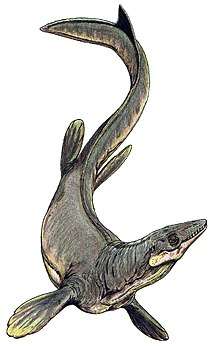Hainosaurus
Hainosaurus (Haino from the river Haine, where it was first discovered, and saurus, from Greek sauros, meaning lizard) is an extinct genus of marine reptiles belonging to the mosasaur family. It is one of the largest mosasaurs, though its size has been revised more than once. At first it was estimated to be 17 metres (56 ft), and the largest mosasaurid.[1] During the 1990s, its size was revised to 15 metres (49 ft) long;[2] more recently, Johan Lindgren estimated that it reached lengths of up to 12.2 metres (40 ft).[3] It was one of the top marine predators of the Late Cretaceous. Like other giant mosasaurs, this giant predator preyed on turtles, plesiosaurs, pterosaurs, cephalopods, sharks, fish, and smaller mosasaurs.
| Hainosaurus | |
|---|---|
| Skull, Natural History Museum of Belgium (Brussels) | |
| Scientific classification | |
| Kingdom: | Animalia |
| Phylum: | Chordata |
| Class: | Reptilia |
| Order: | Squamata |
| Superfamily: | †Mosasauroidea |
| Family: | †Mosasauridae |
| Subfamily: | †Tylosaurinae |
| Genus: | †Hainosaurus Dollo, 1885 |
| Species | |
| |
The fossils of H. pembinensis were found in the Upper Cretaceous Pierre Shale in Manitoba, Canada in 1988. It was distinguished from Tylosaurus by having a greater number of vertebrae before the tail, a larger femur to humerus ratio, and larger nostrils. However, a 2008 study found that conclusion to be problematic, and thus reclassified into the genus Tylosaurus as T. pembinensis.[4] Likewise, Hainosaurus neumilleri Martin, 2007 is a nomen dubium within Tylosaurus.[5]

Hainosaurus is a member of the subfamily Tylosaurinae, and it is related to the wholly North American Tylosaurus. However, it has more vertebrae from the neck to the part of the tail with chevrons (53) than Tylosaurus (35). Both genera are large marine superpredators. Hainosaurus' tail has less chevron-bearing vertebrae, making it shorter than that of Tylosaurus. The type species of Hainosaurus is H. bernardi, named after the Belgian Léopold Bernard, owner of the phosphate chalk exploitation where the fossil was unearthed.[6] In a paper published in 2016, Hainosaurus was considered congeneric with Tylosaurus.[7]
References
- Russell, D. A. 1967. Systematics and morphology of American mosasaurs (Reptilia, Sauria). Yale Univ. Bull 23:241. pp.
- Lingham-Soliar, T. 1998. Unusual death of a Cretaceous giant. Lethaia 31:308–310.
- Johan Lindgren (2005) The first record of Hainosaurus (Reptilia: Mosasauridae) from Sweden. Journal of Paleontology: Vol. 79, No. 6, pp. 1157–1165
- Bullard, T. S.; Caldwell, M. W. (2008). "Redescription and rediagnosis of the tylosaurine mosasaur Hainosaurus pembinensis Nicholls, 1988, as Tylosaurus pembinensis (Nicholls, 1988)". Journal of Vertebrate Paleontology (2): 416–426. doi:10.1080/02724631003621870.
- PA Jiménez-Huidobro, 2016. Phylogenetic and Palaeobiogeographical Analysis of Tylosaurinae (Squamata: Mosasauroidea). University of Alberta, Ph.D dissertation.
- Dollo, L., 1891. La vie au sein des mers. Paris, Librairie J.B. Baillière et Fil
- Paulina Jimenez-huidobro and Michael W. Caldwell (2016). "Reassessment and reassignment of the early Maastrichtian mosasaur Hainosaurus bernardi Dollo, 1885, to Tylosaurus Marsh, 1872". Journal of Vertebrate Paleontology. Online edition: e1096275. doi:10.1080/02724634.2016.1096275.
See also
